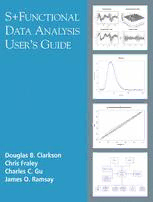Table Of Content+
S Functional Data Analysis
Douglas B. Clarkson
Chris Fraley
Charles C. Gu
James O. Ramsey
S(cid:1) Functional
Data Analysis
®
User’s Manual for Windows
With 79 Illustrations
DouglasB.Clarkson CharlesC.Gu
InsightfulCorporation InsightfulCorporation
1700WestlakeAve.N. 1700WestlakeAve.N.
Seattle,WA98109 Seattle,WA98109
ChrisFraley JamesO.Ramsey
InsightfulCorporation McGillUniversity
1700WestlakeAve.N. 1025Dr.PenfieldAve
Seattle,WA98109 Montreal,QuebecH3A1B1
With79illustrations.
Insightful,InsightfulCorporation,“Insightfulintelligencefromdata”,S-PLUS,S+,S-PLUS
Graphlets,Graphlets,andInFactareregisteredtrademarksofInsightfulCorporation.Insightful
Miner,ArrayAnalyzer,FinMetrics,NuOpt,SeqTrial,Wavelets,andSpatialStatsaretrademarks
ofInsightfulCorporation.Allproductnamesmentionedhereinmaybetrademarksor
registeredtrademarksoftheirrespectivecompanies.
LibraryofCongressControlNumber:2005924801
ISBN-10:0-387-24969-9 Printedonacid-freepaper.
ISBN-13:978-0387-24969-9
©2005InsightfulCorporation
Allrightsreserved.Thisworkmaynotbetranslatedorcopiedinwholeorinpartwithoutthe
written permission of the publisher (Springer Science+Business Media, Inc., 233 Spring Street,
New York, NY 10013, USA), except for brief excerpts in connection with reviews or scholarly
analysis.Useinconnectionwithanyformofinformationstorageandretrieval,electronicadapta-
tion,computersoftware,orbysimilarordissimilarmethodologynowknownorhereafterdevel-
opedisforbidden.
Theuseinthispublicationoftradenames,trademarks,servicemarks,andsimilarterms,even
iftheyarenotidentifiedassuch,isnottobetakenasanexpressionofopinionastowhether
ornottheyaresubjecttoproprietaryrights.
PrintedintheUnitedStatesofAmerica. (MVA)
9 8 7 6 5 4 3 2 1 11371380
springeronline.com
ACKNOWLEDGMENTS
The software for the Functional Data Analysis module was originally
written by Jim Ramsay, Department of Psychology, McGill
University, and Bernard Silverman, Department of Mathematics,
University of Bristol. We have contributed enhancements and
extensions, and attempted to reflect their zeal for the analysis of
functional data. We have benefited from contributions by James
Schimert, and comments by Tim Hesterberg at Insightful
Corporation. Our efforts were funded by NIH SBIR grants
1R43CA86539-01 and 2R44CA86539-02 entitled: An S-Plus
Functional Data Analysis Module.
CONTENTS
Acknowledgments iii
Preface ix
Chapter 1 Introduction 1
Introductory Tutorial (Height Data) 4
A Linear Model for the Height Data 12
Cluster Analysis of the Height Data 15
FDA Flow Chart 21
Chapter 2 Basis Objects and Operations 23
What is a Basis? 24
Basis Objects 25
Choosing a Univariate Basis 26
Choosing a Bivariate Basis 28
Creating Univariate Bases 29
Creating Bivariate Bases 39
Operations on Univariate Bases 41
Operations on Bivariate Bases 44
Chapter 3 Functional Data Objects and Operations 45
Univariate Functional Data Objects (Pinch Force Example)
48
v
Contents
Bivariate Functional Data Objects (Example) 61
Chapter 4 Linear Differential Operators and Smoothing
71
Linear Differential Operators 72
Smoothing via a Roughness Penalty 73
Specifying the Penalty Function 79
Chapter 5 Functional Registration 87
Analytic Registration 89
Lip Motion Example 91
Landmark Registration 96
Chapter 6 Functional Linear Models 101
Example with a Functional Dependent Variable 106
Example with Functional Independent Variables 110
Example with Functional Dependent and Independent
Variables 115
Chapter 7 Functional Generalized Linear Models 123
Weather Example 125
Polychotomous Classification 129
Chapter 8 Functional Principal Components 131
Analysis of the Bone Shape Data 135
Chapter 9 Canonical Correlation 145
Analysis of the Gait Data 147
Chapter 10 Functional Cluster Analysis 155
Clustering Precipitation Data 157
Clustering Temperature Data 162
Summary 164
vi
Contents
Chapter 11 Principal Differential Analysis 165
S+FDA Functions for Principal Differential Analysis 168
Radioactive Decay Example 169
Harmonic Oscillator Example 173
Lip Movement Example 178
Appendix: References 187
Index 189
vii
PREFACE
The book is intended as a guide to the functional data analysis
software in the S+FDA library. It gives a general overview, and treats
each topic through illustrative examples. The code for the examples
can be found in the script files provided with the software, which also
include additional examples. Users can learn to use the S+FDA
library by executing the example scripts while reading. Details on the
functions and their arguments, as well as further examples, can be
found in the associated help files.
1
INTRODUCTION
Installation 3
Object-oriented Programming 3
Introductory Tutorial (Height Data) 4
Selecting the Basis Functions 5
Smoothing 7
A Linear Model for the Height Data 12
Discussion 14
Cluster Analysis of the Height Data 15
Computing a Distance Matrix 15
Displaying the Cluster Mean Functions 17
Between Cluster Distances 18
Summary 19
Multidimensional Scaling 19
FDA Flow Chart 21
1
Chapter 1 Introduction
Functional data arise in many fields of research. Measurements are
often best thought of as functions, even in cases where the data is
gathered at a relatively small number of points. Examples include
weather changes, stock prices, bone shapes, growth rates, health
status indicators, and tumor size.
For time-dependent data, observations may be viewed as realizations
of a smooth function y(cid:11)t(cid:12) of time that have been measured (with
error) at specific time points t , but which could have been measured
j
at any time. Spatial functional data is also common, e.g., the length of
a bone along an axis, the concentration of a drug in a tissue as a
function of depth, yearly mean temperature as a function of location.
Historically, functional data have been analyzed using multivariate or
time-series methods at discrete measurement points. Analyzing
functional data instead as functions has several advantages:
• Functions, unlike raw data, can be evaluated at any “time”
point. This is important because it allows the use of statistical
methods requiring evenly-spaced measurements and allows
extrapolation for use in predictions or treatment decisions.
• Functional methods (e.g., functional principal components,
functional canonical correlation) apply even when the data
have been gathered at irregular intervals, or at different times
on different subjects, when multivariate analogues of these
methods are either inappropriate or unavailable.
• Derivatives and integrals of functions may provide important
information about the underlying process. For example,
knowledge of the direction and rate of change of a patient’s
temperature may be more important than knowledge of the
patient’s current temperature.
Functional methods can also be used when the parameters to be
estimated are functions. Ramsay and Silverman (1997) use smoothing
spline methods for density estimation, and to estimate the link
function in generalized linear models. Another example is regression
splines for fitting time-dependent hazard regression models
(Kooperberg and Clarkson, 1997).
2

